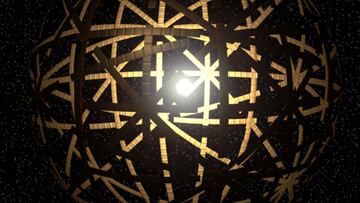What are Dyson spheres, the proof of extraterrestrial life that astronomers are looking for?
Scientists have been searching for extraterrestrial life for decades. One group is now looking for signatures of technology rather than radio signals.

Since time immortal, people have wondered about there being life beyond Earth. Whether or not we are alone in the universe is a question that we are still far from answering. Experts have dedicated their efforts to being able to find signs of life on another planet, such as on Mars with the presence of the Perseverance rover.
But these endeavors do not focus only on small remains that may appear on the surface of Mars or any other remote planet. Another avenue of research has to do with the hypothetical development of advanced extraterrestrial structures, which have been called Dyson spheres. This is the objective of the Hephaistos Project.
In order to measure the technological level of a hypothetical extraterrestrial civilization, astronomer Nikolai Kardashev proposed a scale in the 1960s. This scale, which bears his surname, was popularized thanks to astronomer and popularizer of science and space Carl Sagan. To measure the different classifications in it, they were based on the amount of energy used by a civilization.
According to this expert, and taking as reference the Kardashev scale, our own terrestrial civilization has not yet reached the Type I civilization, the lowest of all and which is capable of controlling and taking advantage of all the energy available on the planet (wind, geothermal and seismic). As for the most advanced, Type III, it can manipulate and control all the energy of not just its solar system but of its entire galaxy. In the most developed type, they could harness the energy from stars.
Theory of Nikolai Kardashev on advanced civilization pic.twitter.com/rhGKxQ5ig6
— Historic Vids (@historyinmemes) April 7, 2024
According to a group of astronomers, who are part of the Hephaistos project, it should be possible to observe technological signals from such advanced civilizations. In order to do this, these signals may be able to be identified in data already obtained by different telescopes, such as Gaia. And one of the structures, as published in the Monthly Notices of the Royal Astronomical Society (MNRAS), would be the Dyson Sphere.
Behind the Dyson spheres
On the aforementioned scale, in order for Type II civilizations to be able to take advantage of all the available energy of a star, they would need the use of structures to capture said energy. And these structures would be Dyson spheres, envisioned by the physicist Freeman Dyson. Built around a star, they would be able to capture and use its energy.
Related stories
According to this theory, these spheres would emit a characteristic technosignature if they exist. This would be in the form of infrared emissions from waste heat and with a different radiation wavelength than that of the star they orbit.
Through the analysis of Gaia, DR3, 2MASS and WISE optical and infrared observations, astronomers from Sweden claim that it should be possible to find signs of Dyson spheres, analyzing the position and speed of stars and objects. And, with this, they believe that seven stars show signs that indicate a possible signal from the sphere and deserve further investigation. However, while the “astrophysical phenomena cannot easily account for the observed infrared excess emission” it is still too early to confirm its existence.


Complete your personal details to comment